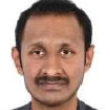
Hari Jyothula
Work place: Ministry of Education, Abu Dhabi, UAE
E-mail: hari.jyouthula@ese.gov.ae
Website:
Research Interests: Image Processing, Machine Learning, Artificial Intelligence and Applications, Artificial Intelligence
Biography
Hari Jyothula has received his Ph.D degree in Digital Image Processing from the Department of Computer Science and Engineering, JNTU, Kakinada. He has a total of 15 publications in SCI, SCOPUS and international conferences. His area of interest is in Image Segmentation, Machine Learning and Artificial Intelligence for Image Processing applications.
Author Articles
Infrared and Visible Image Fusion (IVF) Using Latent Low-Rank Representation and Deep Feature Extraction Network
By Teku Sandhya Kumari Gundala Sujatha Boddeda Sravya Hari Jyothula
DOI: https://doi.org/10.5815/ijigsp.2024.03.03, Pub. Date: 8 Jun. 2024
The combination of visible and infrared images from different sensors can provide a more detailed and informative image. Visible images capture environmental details and texture, while infrared sensors can detect thermal radiation and create grayscale images that have high contrast. These images are useful for distinguishing between target and background in challenging conditions, such as at night or in inclement weather. When these two types of images are fused, they create high- contrast images with rich texture and target details. In this paper, an effective image fusion technique has been developed, which utilizes Latent Low Rank Representation (LatLRR) method that decomposes the source images into latent low rank and salient parts to capture common and unique information respectively. The proposed network design incorporates the dense network and VGG-19 architectures for deep feature extraction of latent low- rank and salient parts, that minimize distortion while maintaining crucial texture and details in the output. Weighted average fusion strategies are used to combine these latent low-rank and salient parts, and the resulting fused features are used for feature reconstruction to generate a fused low-rank and salient part. These parts are integrated to yield a fused image output. The proposed approach out performs existing state-of-the-art methods on both visual characteristics and objective evaluation metrics.
[...] Read more.Other Articles
Subscribe to receive issue release notifications and newsletters from MECS Press journals